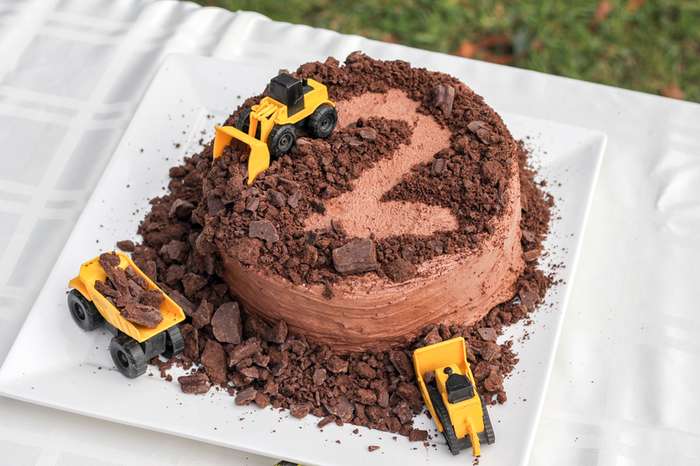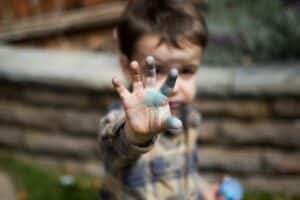The terrible two is a phrase that is used to describe the challenging behavior of toddlers aged between 18 months and 3 years old. This developmental phase can be difficult for both parents and children. As a parent, it is important to know how to handle the terrible twos. Moreover, you should be able to recognize the signs so that you can deal with them effectively.

What Are The Terrible Twos?
The terrible twos is a period that begins at two years old and is characterized by frequent temper tantrums, rapid mood swings, and other times it’s difficult to control one’s impulses.
Your toddler may act out and display any number of emotional states in a single hour, whether happy or furious, ecstatic or melancholy.
One minute he’ll be playing joyfully with his toys, and the next he’ll be throwing a furious fit because you misplaced his favorite green sippy cup. The emotional roller coaster that is the terrible twos can be exhausting for both parents and toddlers alike.
What Causes The Terrible Twos?
Another reason is that toddlers this age are going through significant changes in child development, and their cognitive and emotional abilities have improved.
Even if your kid doesn’t always understand what you’re saying, he can ask for things. He’s also capable of doing more on his own. As a result, there’s a sizable amount of frustration, which is why this phase has a not-so-good reputation and an intimidating name.
The terrible twos can be a trying time for both parents and kids. However, it’s a phase that all children go through, and it doesn’t last forever. With some patience and understanding, you’ll make it through to the other side.
When Do The Terrible Twos Begin?
This stage of two years has no specific name, although it is sometimes referred to as “terrible twos.” Because the child doesn’t have all of the words he needs to convey what he wants from you, he would be sad, irritated, or weary at this period.
For example, he may not be able to say that he doesn’t want to visit the doctor’s office or that he does desire to go to the playground.
Can the terrible twos start early? Yes, the terrible twos may begin at any age. They may not occur immediately after a child’s second birthday. Instead, they might begin later or sooner, depending on the kid.

How Long Do Terrible Twos Last?
The terrible twos may rapidly develop into the awful threes. However, by the time a youngster is four years old, he or she should have enough language and motor ability to communicate, comprehend instructions, and comply with rules set by instructors and caretakers.
This is typically the age when children begin attending preschool or daycare, which can help facilitate their socialization skills and provide a structured environment in which they can learn how to follow rules. It’s also around this time when many parents start to see improvements in their child’s behavior.
If your child is still acting out at age four or older, it may be indicative of a more serious problem, such as a developmental delay or Oppositional Defiant Disorder. If you’re concerned about your child’s behavior, talk to his or her pediatrician.
Signs Of Terrible Twos
- Frustration – Your toddler will become discouraged for a variety of reasons, including the fact that he can’t flush the ball down the toilet.
- Overindulgence In Feelings – He’ll laugh violently at something funny, or he’ll scream in anguish, both of which will be loudly roared from the top of his lungs.
Other Signs Include:
- Temper Tantrums.
- Opposition.
- Frequent mood changes.
- Zero Patience.
- A desire to accomplish everything on your own, especially if you’re in a hurry.
- Feeling cranky during the nap-time and feeding times.
Do All Children Go Terrible Twos?
The terrible twos begin at 18 months and can last for years. Most young kids, at least in the Western world, where there are certain societal expectations for children’s conduct, will exhibit some symptoms of the terrible twos.
Some children will have fewer terrible twos temper tantrums than others. This is especially true if they have good language skills, which help them to communicate more effectively and minimize aggravation.
Some parents try to avoid the terrible twos altogether by giving their children more attention and love during this difficult time. Others think that it’s just a phase that all children go through and that their child will eventually outgrow it.
How Many Daily Tantrums Is Normal, And What Should You Do As A Parent?
Anyone could out-tantrum your child. Fortunately, not all babies have the same number; however, some may have more. It will all be determined by the child.
Some infants may tantrum 10 times a day while others may only tantrum 3 times a week. It all depends on the baby and their temperament. As a parent, you will have to learn how to deal with your child’s tantrums.
If your infant is having multiple daily tantrums or aggressive episodes, it is important to try and figure out what is causing them. There could be several reasons such as teething, hunger, fatigue, or overstimulation. Once you figure out the cause, you can try to prevent the tantrums from happening.
How To Handle The Terrible Twos?
Try to view this time as more advantageous than unfavorable, and keep these ideas in mind:
- Maintain A Daily Schedule – Toddlers like predictability since it makes them feel secure. As a result, try to keep your meals, play, and sleep times consistent.
- Keep In Mind The Time They Get Tired And Hungry – When we’re weary or hungry, we all get irritable. So keep some nutritious snacks on hand to avoid hunger pangs and don’t go out for errands when your baby is napping.
- Give Your Child Options To Select From – Allow him to select whether he wants to eat cornflakes or waffles for breakfast, as well as what color sweatshirt he wishes to wear. The less control he has over minute details, the less dissatisfied he’ll be.
- Divert His Attention Whenever He Throws a Tantrum – It’s as simple as telling knock-knock jokes, singing a goofy song, or going somewhere else in the park to manage the terrible twos.
- Choose Your Battles Carefully – “No” to every request may make your toddler feel ignored. So be a pushover now and again within reason. After you’ve dropped off your little one at daycare, go for a walk on the swing set. However, don’t give in to a tantrum just because it’s tempting.
- Praise Him For Behaving Good – Praise by saying – Thank you for asking nicely and using your words, or Thank you for being so patient while we were waiting in line.
How To Prevent The Terrible Twos?
It’s possible to anticipate your child’s trigger points and stop tantrums in the bud. Here’s how to deal with terrible twos and prevent their meltdown:
One of the most effective methods to make kids understand a problem is to tell them what they should expect.
Giving your toddler a sense of what lies ahead as well as what has already happened is a good idea. “Toddlers are unaware of the timetable and have their strategies, so you can assist them to anticipate future actions.
Tantrums can be avoided by predicting your child’s emotional state and avoiding overloading him with activities and choices, especially if he’s had a difficult day.
When Do The Terrible Twos End?
They may continue until your child is three or even four years old. But bear in mind that as your child develops self-control and discovers new ways to communicate his feelings, he will not be as furious and therefore have fewer tantrums.
Even if you don’t want to believe it, you can probably anticipate a temper tantrum after a particularly stressful day at school or when he’s tired or hungry (or both) until he reaches the age of four.
What comes after the terrible twos? The terrible twos and threes can last for months or even years, respectively. However, these will not be the end of your parenting problems. Your toddler will continue to bring you new surprises that you must accept.
What Should You Never Do To Fight The Terrible Twos?
Nobody is expecting continuous tantrums. There’s no way to process all phases of a child’s development in a brief time. Some parents become perplexed and unsure of how to handle them.
Punishments of any sort, including screaming, will not assist you but may embitter your child. He is already terrified of not knowing what is going on with him, so increasing his anxiety doesn’t appear to be a good idea, no matter how weary or irritated you become.
Another thing to keep in mind is that the terrible twos are not a punishment for being born. It’s a phase of development that your child has to go through. Just as you went through it, and just as your parents did. It’s a necessary part of growing up, and it doesn’t last forever. So try to be patient, and try to see the situation from your child’s point of view.

Frequently Asked Questions
Q1: Why does my child get so angry?
Ans: Your toddler’s vocabulary is still developing to the point where they can effectively communicate. They know many of your orders and demands, but they lack the language to explain to them as they learn new words and phrases to express their meaning properly. This imbalance in emotions is the primary cause of defiant behavior.
Q2: What are terrible twos symptoms?
Ans: Tantrums that are accompanied by hitting, kicking, biting, or other types of physical abuse against the parent or caregiver. self-injury in tantrums is also a symptom of terrible twos.
Q3: What can I expect from terrible twos?
Ans: The term “terrible twos” refers to a typical phase in a youngster’s development, during which a kid may fluctuate between depending on adults and establishing an interest for independence. The symptoms can differ from one child to the next, although they might include frequent mood swings and temper tantrums.
Q4: Do terrible two tantrums affect sleep?
Ans: While it’s typical for infants to wake several times throughout the night, most toddlers will wake less and many will begin to sleep through as they enter this stage.
Q5: What are the signs of 2 year old tantrums?
Ans: There are a few key signs that may indicate your child is experiencing behavioral problems. These can include acting out in aggressive or destructive ways, having difficulty following instructions, exhibiting extreme tantrums or meltdowns, and engaging in self-injurious behaviors.
Q6: How is autism or terrible twos at 18 months?
Ans: The symptoms of autism usually appear by 18 months, although they can start as early as six months old. The most common symptom is a delay in speech and language development. Other symptoms may include repetitive bad behavior, difficulty making eye contact, and lack of interest in social interactions.
Conclusion
Terrible two is a normal stage of child development. However, it can be a challenging time for both parents and children, but it’s important to remember that this phase is only temporary. There are a few things you can do, such as remain calm, take a deep breath, be patient, establish routines, and provide plenty of love and support. If you’re concerned about your child’s behavior, be sure to talk to their doctor.







